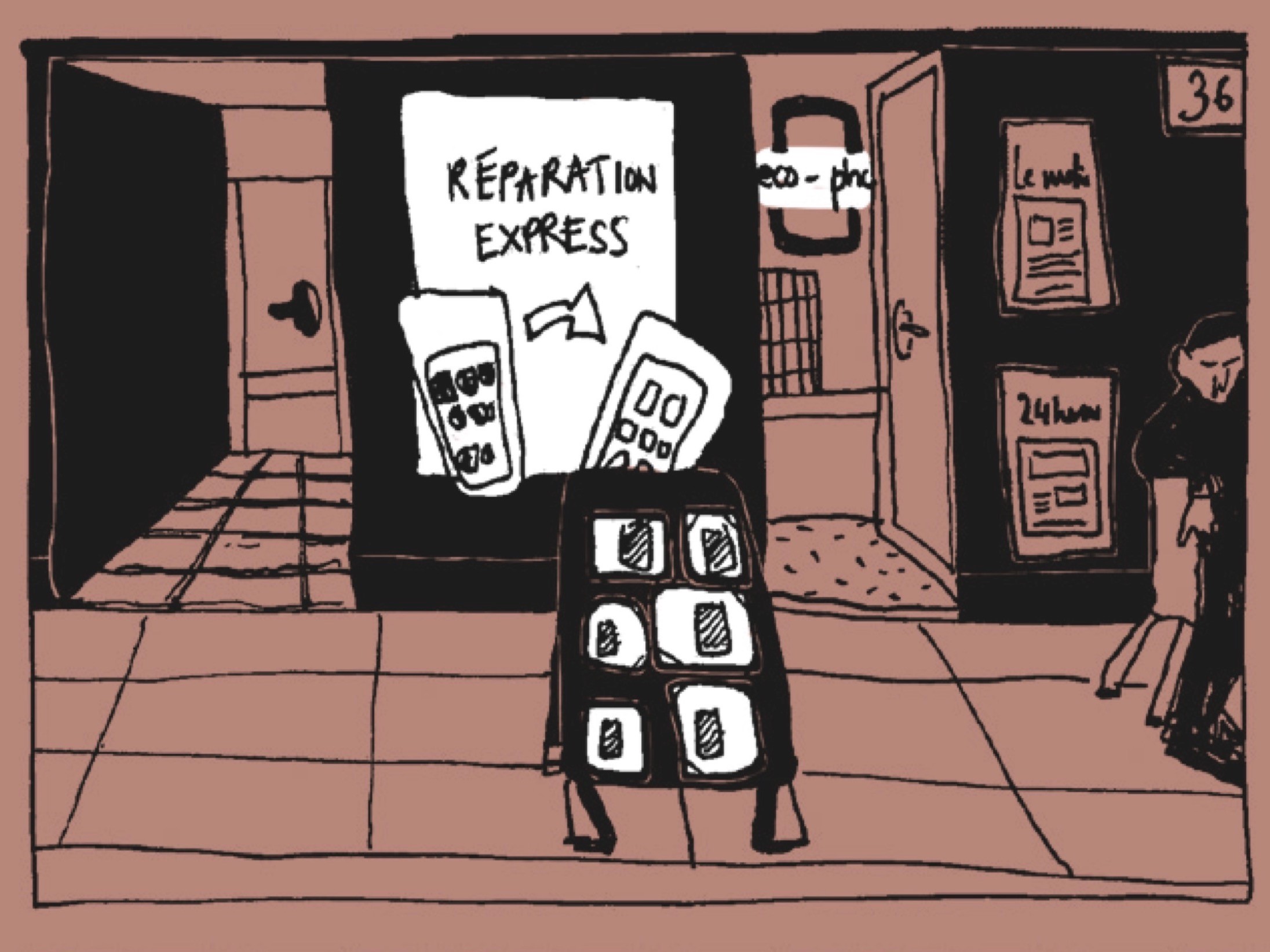an opportunity to learn
unmaking as a form of knowledge production
about this contribution
The visuals represented here derive from a two-year ethnographic project about smartphone repair practices in Switzerland, focusing on repair stores, hackerspaces, fab labs, and temporary venues such as repair cafés, which mostly focus on the material elements of the hardware (broken screens or buttons) and software issues (data recovery, setting updates, applications installation, etc.). Spending time in these shops over several months, allowed us to understand the positive social dimensions they have in local neighborhoods: while customers sometimes come to drink a cup of coffee and seek help with hardware issues (broken screens and damaged buttons), the repairers also help with minor problems for free (restoring settings, changing language or notification configurations) and sometimes fulfill roles way beyond their stated function, for instance by helping with administrative services (such as booking appointments online or filing tax forms).
Our investigation addressed the practices of the technicians who founded, or operate, these places. We focused on how these individuals come to end up fixing customers’ devices, and more specifically, on how they learned to handle products that manufacturers did not design to be repaired. This project hypothesized that a greater understanding of digital artifact maintenance is fundamental to meet the challenges of an era of environmental crisis and consumer waste. The description of repairers’ practices, and the way they build their own know-how and expertise, highlight users’ efforts to improve the sustainability of their technical objects, regardless of manufacturers’ intentions.
Focusing on repair stores, this comic strip visually describes the importance of “unmaking” as a learning tactic that repairers adopted to generate knowledge about the objects they plan to fix. This series of ethnographic vignettes illustrates the information these practitioners uncover by disassembling new phone models, documenting their manipulations, and sharing them with local and regional peers through media such as WhatsApp groups. This way of working against manufacturers can be seen as a form of “counter-making” (contre-faire) (Allard 2015, 164), mirroring the notion of “critical making” proposed by Matt Ratto in order to refer to knowledge generation emerging through material engagement with technology (Ratto 2011, 253).
From a methodological perspective, this contribution also illustrates the visual dimension of the notion of “ethnographic vignette” (a situation observed and extracted from the field) that interested us in this project both for pragmatic reasons (observational drawing as a means of gaining acceptance in the field) and as an epistemological choice (in order to explore alternative formats of ethnographic accounts). Interestingly, this design choice was made because over the two years of the research project, several participants expressed their reluctance to being filmed and photographed, with some mentioning that they lacked the necessary work permits and risked being identified. As a consequence, the use of drawings became a solution to be respectful of these repairers, a way to avoid being too intrusive in their work context. However, we used photography to document the context of these shops as well as their material culture, with devices, tools, and ways of communicating. The combination of field drawings with these pictures highlights what “counter-making” actually means, from testing a dismantled device to solving a client’s problem.
credits
authors: Anaïs Bloch (HEAD – Genève, HES-SO) & Nicolas Nova (HEAD – Genève, HES-SO)
drawings: Anaïs Bloch
interaction designer: Arp is Arp Studio (Dimitri Charrel)
copy editing: Bronwyn Mahoney
supported by: the Swiss National Fund.
references and rights
illustration copyrights
read more read less
Anaïs Bloch & Nicolas Nova. 2021. Dr. Smartphones: An Ethnography of Mobile Phone Repair Shops. Copyright 2021 by the authors. Reproduced with permission.
bibliography and references
read more read less
Allard, Laurence. 2015. “L’engagement Du Chercheur à l’heure de La Fabrication Numérique Personnelle”. Hermès 3, no. 73: 159–167.
Ratto, Matt. 2011. “Critical Making: Conceptual and Material Studies in Technology and Social Life.” The Information Society 27, no. 4: 252–260.
to cite this article
This article is using Chicago format for its references
Bloch, Anaïs & Nicolas Nova. 2023. “An Opportunity to Learn: Unmaking as a Form of Knowledge Production.” .able journal: https://able-journal.org/en/an-opportunity-to-learn
cite this article
MLA
EN
Bloch, Anaïs and Nicolas Nova. “An Opportunity to Learn: Unmaking as a Form of Knowledge Production.”.able journal, 2023. https://able-journal.org/en/an-opportunity-to-learn
ISO 690
EN
BLOCH, Anaïs, and NOVA, Nicolas. An Opportunity to Learn: Unmaking as a Form of Knowledge Production. .able journal [online]. 2023. Available from: https://able-journal.org/en/an-opportunity-to-learn
APA
EN
Bloch, A. & Nova, N. (2023). An Opportunity to Learn: Unmaking as a Form of Knowledge Production. .able journal. https://able-journal.org/en/an-opportunity-to-learn
discover on social media
Use the links below to share a suitable version of this contribution on social media:
coming soon…
print this contribution
Use the links below to print this contribution. You have the choice between a high-quality format or an eco-quality format optimized to reduce environmental impact.








